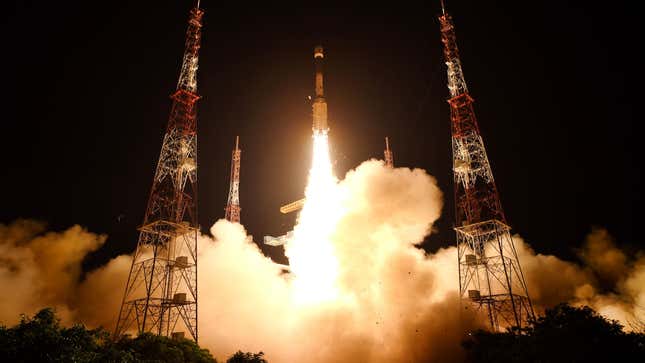
India’s space agency says an unknown technical glitch prevented the upper stage of its GSLV-F10 rocket from igniting, in what is a frustrating setback for the burgeoning space power.
India’s Geosynchronous Satellite Launch Vehicle-F10 (GSLV-F10) blasted off from Satish Dhawan Space Center in Sriharikota at 5:34 a.m. local time on August 12. The first and second stages went as planned, but shortly before the five-minute mark of the mission, when the third and final stage was supposed to ignite, nothing happened.
The Indian Space Research Organisation (ISRO) was brief in its description of the failed launch, saying “ignition did not happen due to technical anomaly,” so the “mission couldn’t be accomplished as intended.”
The upper stage was supposed to deliver the EOS-03 Earth observation satellite to geosynchronous orbit (also known as GEO), in which objects can stay in orbit over Earth at a fixed position. Peering perpetually at the Indian subcontinent, EOS-03 was going to track severe weather, like cyclones, cloud bursts, and thunderstorms. The satellite was also supposed to gather data relevant to agricultural, forest, and marine industries. Instead of doing its business in space, however, the satellite is now a shattered, burnt-out mess at the bottom of the Indian ocean.
In a tweet, spaceflight expert Jonathan McDowell from the Harvard-Smithsonian Center for Astrophysics said the satellite and third stage likely fell into the Andaman Sea, near the area where the second stage was expected to fall.
Without the third stage kicking in, there was no chance for the satellite to reach geosynchronous orbit. The rocket reached a maximum height of 87 miles (140 km), so it technically managed to reach space, but at velocities no faster than 15.7 feet per second (4.8 km/second), the rocket was moving “well short of the speed required to enter orbit,” as SpaceFlightNow reports. Fairing separation should’ve occurred 18 minutes and 34 seconds after launch, with an expected speed of 33.46 feet per second (10.2 km/second), as ISRO points out in a mission brochure.
Speaking of the fairing, this was the first launch of GSLV with a new 13-foot-long (4-meter) fairing, which is designed to carry larger payloads. It’ll be interesting to know if this new component, called the Ogive Payload Fairing, had anything to do with the failed launch. Seems unlikely, but who knows.
India has been ambitious about space for over a decade now, developing its own rockets, satellites, and communications systems. The nation managed to send a probe to Mars in 2014, and it plans to send its first astronauts to space in 2022. In 2019, India failed to land its Vikram probe on the Moon, and, in a self-declared expression of “space power,” India shot down its own satellite.